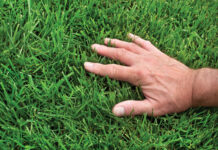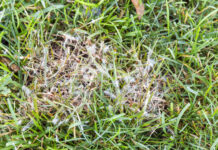By Debbie Stringer
From the August 2023 Issue
Today’s rain events are becoming more frequent and intense. Flooding is happening in areas previously not prone to it. As development replaces permeable surfaces, the ability of aged infrastructure to collect stormwater runoff during high and concurrent rainfall events is not always successful.
When vegetated systems, such as rain gardens, use expanded shale, clay or slate (ESCS) lightweight aggregates, their ability to abate long-term storm damage can be significantly increased.
First and foremost, to prevent flood hazards, stormwater must be able to drain away from streets and structures. And on-site infiltration is the most economical and ecological choice. As a result, municipalities and transportation authorities are requiring more green infrastructure in both new projects and existing sites to capture and slow down runoff.
Vegetated bump-outs, planters, street trees, disconnected downspouts, and rain gardens can be installed to capture rain where it lands. This cumulative effort can reduce the overall volume of runoff and may be able to postpone the enormous task of updating storm sewer systems or incorporating more expensive solutions.
But just as soil can be amended for greater fertility, soil can also be amended for greater absorption—magnifying the effect of organic stormwater capture. When these vegetated systems, such as rain gardens, use expanded shale, clay or slate (ESCS) lightweight aggregates, their ability to abate long-term storm damage can be significantly increased.

What Is ESCS?
ESCS is a ceramic-like aggregate made by expanding and vitrifying raw shale, clay, or slate in a rotary kiln at about 2000 ̊ Fahrenheit. This process shapes a structurally strong, lightweight, environmentally inert and non-toxic material that won’t degrade over time. When cooled, the material has a uniformly distributed network of unconnected pores that act like tiny reservoirs and make the material absorptive, efficiently storing moisture and water-soluble nutrients. ESCS lightweight aggregates also allow excess water to drain freely, reducing the potential for flooding and stormwater damage. For these reasons, ESCS can be an efficient part of a multitude of landscaping applications, playing varied roles yet delivering consistent results. It supports landscape design by offering innovative, cost-effective, and long-term solutions that can help you help clients find more economical solutions to complex stormwater issues.
ESCS In Rain Gardens
One of the major issues in storm-prone areas is flooding. Not only does the flowing water contain solid waste and pollutants that erode streambanks and threaten public health, but it can cause major damage to public and private properties. Thus, slowing and filtering stormwater to remove contamination is crucial to alleviate some of the harm caused by heavy rain events.
ESCS can help in both. Due to its chemically inert and water-absorptive properties, ESCS creates a filtering and growing media. ESCS soils afford plants the ability to establish vigorous root systems—which anchor soil to reduce erosion—while absorbing water and nutrients. The lightweight aggregates have a larger surface area than traditional aggregates, which increases the space for absorbing contaminated stormwater, filtering solid waste, and aiding percolation of filtered water into the water table. For this reason, ESCS is often specified for rain gardens. When planted with perennials and grasses, it’s an easy and cost-effective way to reduce runoff.
More Effective Filter Strips
ESCS lightweight aggregate is also an excellent component to pair with sandy-clay-loam soils. This “designer soil” promotes deeper water and oxygen storage for healthier plant roots, releasing water and nutrients back into the plant root network as the soil begins to dry. In this way, ESCS encourages biodiversity. This can be extremely valuable when designing filter strips, which are areas of vegetation that allow runoff to infiltrate at specified depths.
ESCS in filter strips promotes faster water percolation by filtering it and reducing the amount of time standing water remains exposed, which can lead to mosquito breeding. These filter strips are ideal within parking lots or to define property lines around buildings.
Soil Stabilization/Erosion Prevention
Because ESCS aggregates have a high and predictable internal friction angle, it can help create soils that maintain porosity for years and are resilient against storm-caused erosion. Waterloo Park, one of the largest parks in Austin, TX, utilized ESCS’s properties to stabilize horticulture subsoils. Differing soils were blended to meet the agronomic conditions of the performance lawn, street trees, wetland plantings, landscape beds, general turf areas, and structure plantings. In all specifications, ESCS was a key component for stabilization.
The designed soils are a part of the rainwater capture and filtering system onsite. It allows the performance lawn to drain within minutes of rain, retaining its form to offer firm stable support for equipment and use. The soil also fosters tens of thousands of plants that were installed on the project, providing the necessary moisture, oxygen, and soil microbes to promote the development of larger root systems—which leads to an easier-to-maintain landscape.
Going Underground
Finally, ESCS can be utilized as an underground filter fill to bolster the effectiveness of stormwater management. This application uses the aggregate in a layered fill under permeable pavers, storing 25% more moisture and allowing excess water to percolate into the water table. When a basin or pond isn’t feasible, these interventions can be ideal and have become a popular practice to manage and treat stormwater. They enable appropriate water filtration by removing suspended solids, hydrocarbons, metals, nitrogen, and phosphorus, thereby reducing pollutants in water and ensuring breathability for tree roots.
The University of Texas at Austin (profiled Turf April 2023) opted for greener solutions on its campus and used structural soil below its permeable brick paving to help support both the pavement and the street trees. The soil media contained 80% expanded shale and 20% topsoil mix with organic matter placed at a 24″ to 36″ depth.
The compacted structural soil now supports the permeable brick paving system and extends from the base of the tree to the limits of the permeable brick paving. The porous nature of the structural soil is beneficial in avoiding paver lift around the oak trees by providing passage for the tree roots to grow deep in the air-entrained (or air-pocketed) ESCS soil instead of near the surface. An extra benefit of the expanded shale is it helps to improve the clay soil conditions where the new trees and ornamentals were planted.
After satisfactory results, Peter Walker & Partners, the landscape architects for the campus installation, went on to use ESCS on many of their other projects including the Nasher Sculpture Center, the University of Texas at Dallas, and the UT Southwestern Medical Center’s William P. Clements Jr. University Hospital.
The Best Drought & Flood Tolerant Plants
In an era of weather extremes, here are the best flood and drought tolerant plants for landscapes. Read more…
One Material, Many Applications
Apart from ground and underground applications, ESCS can play a valuable role in green roof design. As a lightweight material, it reduces the deadload placed on a roof structure, allowing more options. ESCS can also retain water and nutrients to contribute to a growing media that supports the long-term success of a green roof. Finally, the excess stormwater collected on the roof can be filtered through ESCS and drained into designed storage systems or the groundwater table for effective stormwater management.
Landscape professionals can harness this material’s capabilities to design beautiful landscapes that also serve as primary a defense against the destructive nature of heavy stormwater runoff. This proactive approach enables Green Industry professionals to enhance customer satisfaction, adhere to evolving codes, reduce the load on the country’s stormwater infrastructure, and make significant contributions to a sustainable future.
 Stringer has worked for Carolina Stalite Company in Salisbury, NC for 24 years, representing ESCS primarily for the landscape, stormwater, and filtration industries. She received her horticulture degree at Sandhills Community College in Pinehurst, NC. As a horticulturist and stormwater professional, she has worked in the Green Industry for 35 years. For more on Stalite, visit stalite.com.
Stringer has worked for Carolina Stalite Company in Salisbury, NC for 24 years, representing ESCS primarily for the landscape, stormwater, and filtration industries. She received her horticulture degree at Sandhills Community College in Pinehurst, NC. As a horticulturist and stormwater professional, she has worked in the Green Industry for 35 years. For more on Stalite, visit stalite.com.
Do you have a comment? Share your thoughts in the Comments section below, or send an e-mail to the Editor at cmenapace@groupc.com.











![[VIDEO] Dickies®: Discover Workwear That’s Anything But Uniform](https://turfmagazine.com/wp-content/uploads/2023/06/1647663814-4b1a2a7742790a9b1e97a3b963477850192e1d6a9dfba9b07214a77bae25d6e3-d-218x150.jpg)




























 The Best Drought & Flood Tolerant Plants
The Best Drought & Flood Tolerant Plants


![[VIDEO] Dickies®: Discover Workwear That’s Anything But Uniform](https://turfmagazine.com/wp-content/uploads/2023/06/1647663814-4b1a2a7742790a9b1e97a3b963477850192e1d6a9dfba9b07214a77bae25d6e3-d-324x160.jpg)
A frequent concern of landowners is to prevent the formation of wetlands, because then they fall under state and federal rules that restrict the use of even surrounding land out to as much as 150 feet. Once a wetland exists, it cannot be removed, so one has to watch that new unwanted wetlands do not form on one’s land. (Obviously, if one wants a pond, one has decided to create a wetland.) I would want to ensure that this material does not promote hydric soil conditions. Generally it sounds great!